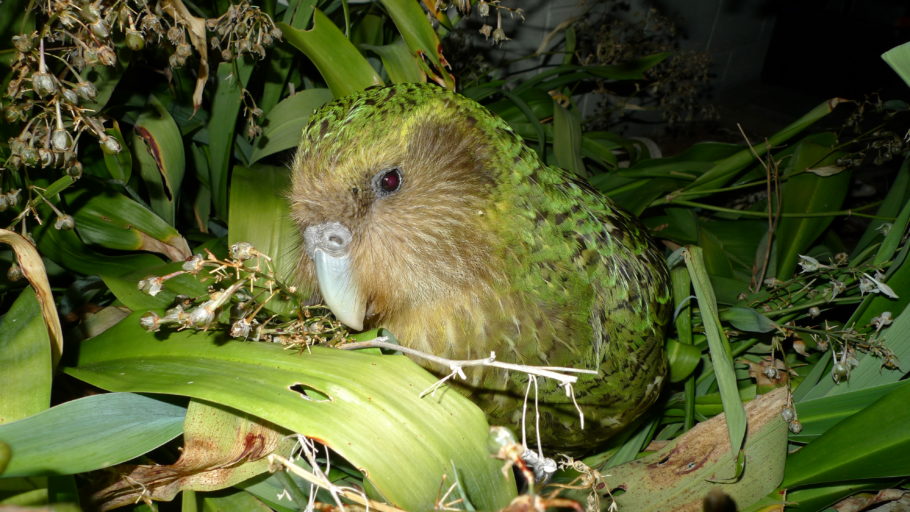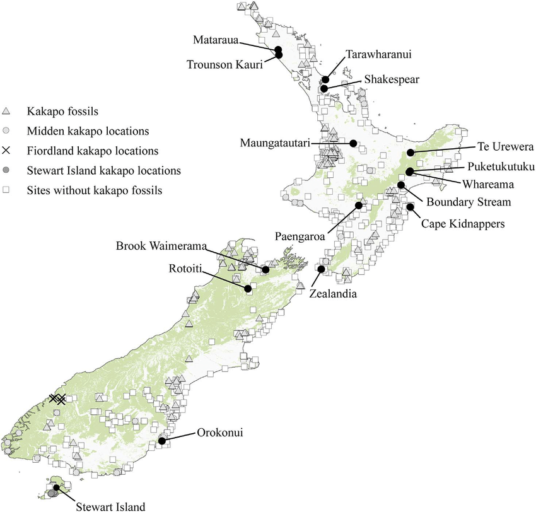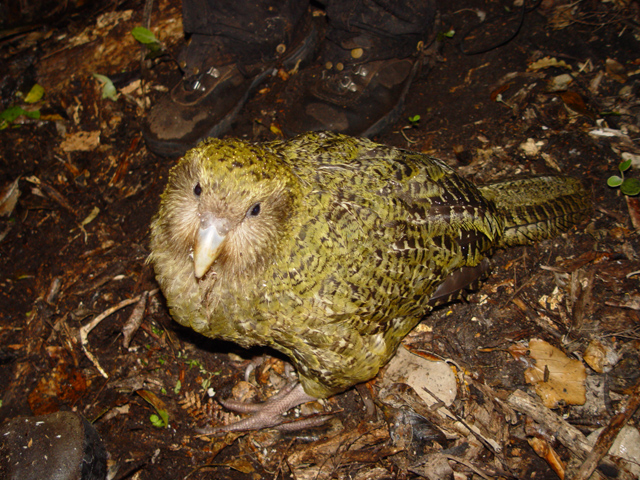The kākāpō population is outgrowing its island refuge – but where might future kākāpō live? In a predator free future, the answer could include protected mainland sites provided there are sites that are big enough, safe enough and with the right kind of habitat for kakapo to thrive. If those likely sites can be identified now, we can ensure they are protected and enhanced and ready when kākāpō need them.

That was the premise of a study carried out by Pia Lentini et al in a paper published in Biological Conservation. But finding the answer isn’t as simple as studying the habitats where remnant populations have most recently survived. The kakapo’s survival in remote areas of Fiordland and Stewart Island may have more to do with a retreat from predators than ideal habitat for the birds, as the researchers explain.
“For conservation managers, establishing new insurance populations when the former extent of a species’ distribution is unknown is fraught with uncertainty. This is because in the case of ‘refugee’ species, the areas where they persist are suboptimal, marginal habitats with their distributions being a legacy of spatial heterogeneity in threatening processes.”
“Consideration of the legacy of these threatening processes is important for conservation managers because scarce resources may be wasted attempting to re-establish populations in unsuitable habitat. Conversely, opportunities to protect and enhance areas of suitable habitat may be missed if they remain unidentified.”
The answer to finding future homes for kakapo lies in identifying where they thrived in the past, before people and mammal predators arrived on the scene and messed things up.
“Areas which support habitat conditions typical of those occupied by kakapo in the past have the greatest potential to support future populations. We collated occurrences of kakapo from recent fossil records, then used MaxEnt to model the past distribution of kakapo across New Zealand, and contemporary areas suitable for reintroductions based on extant habitat and present-day climate. We validated our models against three independent data sets of the most recent relict populations.”
Few, if any kakapo currently survive in the wild.
“Emergency management intervention led to the removal of all known surviving individuals from Stewart Island and the Fiordland region on the South Island to predator-free offshore islands outside of their past distribution from 1972 to 1992. Decades of intensive management of these island populations has resulted in substantial population growth, but the limited carrying capacity of offshore islands is looming as a major challenge for the continued recovery of this species. In the future, conservation managers aim to establish at least one self-sustaining, unmanaged kakapo population as a functioning part of the ecosystem in a protected habitat. To achieve this aim, understanding the past distribution of kakapo is a priority for identifying, preparing and managing potential locations for their release.”

The researchers compiled data on the past distribution of kakapo using 216 Holocene fossil records from dune, swamp and karst sites across mainland New Zealand able to quantify the past suitability of mainland New Zealand for kakapo and areas across contemporary mainland New Zealand which support climates and habitats suitable for potential kakapo reintroductions.
“Locations were collated from published records. The location of Maori midden deposits containing kakapo remains [n= 45] were collated from published records. Finally, the location of fossil sites [n = 603] where avian fossil deposits have been excavated, but which did not contain kakapo fossils, were also collated from published records.”
Mathematical modelling was used to analyse the results.
“Highly suitable areas tended to cluster around the west coast of the South Island, the Waikato and Taranaki regions on the west and north-east tip of the North Island and the southern end of Lake Taupo. Across all three scenarios, potential vegetation type, annual precipitation, and soil drainage had the strongest contribution to model predictions. Our models suggest that kakapo once occurred in mountain beech and Hall’s totara or broadleaf forests with moderate to high precipitation and milder winters. Areas predicted to be environmentally suitable for kakapo in contemporary New Zealand include the west coast of the South Island, the west and north-east of the North Island and the southern side of Lake Taupo.”
“This is in concordance with our current understanding of the species’ ecology, as broad-leaf podocarp and beech forests are characterised by productivity pulses associated with mast fruiting, which have a strong influence on kakapo breeding events on offshore islands. We also assessed the impact of widespread loss of native vegetation and associated degradation across contemporary New Zealand and estimate there has been a 33–48% loss in potential kakapo habitat.”

So where, specifically, might conservation groups and local residents be able to put up a good case as future rehoming sites for kakapo?
“Across our scenario predictions, of the 16 conservation areas tested Whareama and Puketukutuku Peninsulas at Lake Waikaremoana emerged as supporting habitat with the highest likelihood of occupancy (μlikelihood = 0.51 and 0.50 respectively), though these were sites for which we were unable to source spatial information about the specific boundary and thus could not calculate the number of home ranges which might be supported. Boundary Stream Reserve was ranked next after the Peninsulas (μ likelihood =0.41, potentially supporting 0.93–1.31 home ranges) but is an unfenced site, followed by the 3247 ha fenced Maungatautari Ecological Island (μ likelihood =0.37, potentially supporting 1.4–3.8 home ranges).”
So the good news is that, as our island kakapo population keeps growing, there are potential mainland homes for the overflow birds.
“Assuming that known threats of introduced predators can be managed, our study suggests that suitable kakapo habitat persists in New Zealand, and here we offer insight into locations for future population establishment. Given the finite carrying capacity of offshore islands, this is an important first step which will enable kakapo managers to prioritise focal areas and also highlights the benefits and potential pitfalls of using these modelling approaches for refugee species.”
The study is reported in Biological Conservation where only the abstract is freely available. The full paper is, however, available through Researchgate.
Using fossil records to inform reintroduction of the kakapo as a refugee species (2018)

